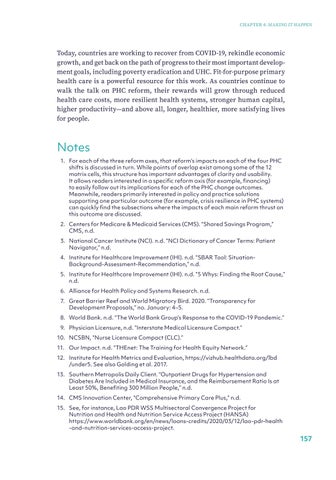CHAPTER 4: MAKING IT HAPPEN
Today, countries are working to recover from COVID-19, rekindle economic growth, and get back on the path of progress to their most important development goals, including poverty eradication and UHC. Fit-for-purpose primary health care is a powerful resource for this work. As countries continue to walk the talk on PHC reform, their rewards will grow through reduced health care costs, more resilient health systems, stronger human capital, higher productivity—and above all, longer, healthier, more satisfying lives for people.
Notes 1. For each of the three reform axes, that reform’s impacts on each of the four PHC shifts is discussed in turn. While points of overlap exist among some of the 12 matrix cells, this structure has important advantages of clarity and usability. It allows readers interested in a specific reform axis (for example, financing) to easily follow out its implications for each of the PHC change outcomes. Meanwhile, readers primarily interested in policy and practice solutions supporting one particular outcome (for example, crisis resilience in PHC systems) can quickly find the subsections where the impacts of each main reform thrust on this outcome are discussed. 2. Centers for Medicare & Medicaid Services (CMS). “Shared Savings Program,” CMS, n.d. 3. National Cancer Institute (NCI). n.d. “NCI Dictionary of Cancer Terms: Patient Navigator,” n.d. 4. Institute for Healthcare Improvement (IHI). n.d. “SBAR Tool: SituationBackground-Assessment-Recommendation,” n.d. 5. Institute for Healthcare Improvement (IHI). n.d. “5 Whys: Finding the Root Cause,” n.d. 6. Alliance for Health Policy and Systems Research. n.d. 7. Great Barrier Reef and World Migratory Bird. 2020. “Transparency for Development Proposals,” no. January: 4–5. 8. World Bank. n.d. “The World Bank Group’s Response to the COVID-19 Pandemic.” 9. Physician Licensure, n.d. “Interstate Medical Licensure Compact.” 10. NCSBN, “Nurse Licensure Compact (CLC).” 11. Our Impact. n.d. “THEnet: The Training for Health Equity Network.” 12. Institute for Health Metrics and Evaluation, https://vizhub.healthdata.org/lbd /under5. See also Golding et al. 2017. 13. Southern Metropolis Daily Client. “Outpatient Drugs for Hypertension and Diabetes Are Included in Medical Insurance, and the Reimbursement Ratio Is at Least 50%, Benefiting 300 Million People,” n.d. 14. CMS Innovation Center, “Comprehensive Primary Care Plus,” n.d. 15. See, for instance, Lao PDR WSS Multisectoral Convergence Project for Nutrition and Health and Nutrition Service Access Project (HANSA) https://www.worldbank.org/en/news/loans-credits/2020/03/12/lao-pdr-health -and-nutrition-services-access-project.
157


